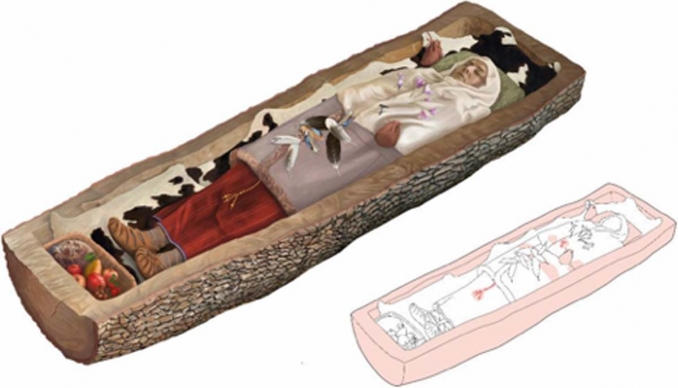Discovery of ancient remains of Celtic woman in 'Tree Coffin' in Switzerland reminds us of when Celts held sway across Europe and beyond.
In 2017 the ancient remains of a Celtic woman buried in a coffin made from a hollowed out tree was discovered in Zurich, Switzerland. It is thought that she died about 2,200 years ago. Dressed in fine clothes and adorned with jewellery, it is clear she was someone of high standing. Since the discovery work has been undertaken by the city of Zurich's archaeology department to discover more about this Iron Age Celtic woman's life in 200 BC. As reported in the science news website Live Science, she was aged about forty when she died and an isotope analysis of the woman's bones showed that she was a local who grew up in Zurich, likely in Limmat Valley. They point out that, "the archaeologists were especially intrigued by the clasp on the woman's necklace. Both ends of the necklace had a garment clip known as a brooch that allowed her to wear the string of blue and yellow glass and amber beads," and that, "the woman also wore bronze bracelets and a delicate bronze belt chain with pendants hanging from it. Several iron clasps held her clothes together."
The discovery reminds us that the Celtic peoples at one time lived across much of Europe. Many who think of the Celts now look at those areas of the globe that still have a strong Celtic identity. Including the six Celtic nations of Brittany (Breizh), Cornwall (Kernow), Ireland (Éire), Isle of Man (Mannin), Scotland (Alba) and Wales (Cymru), which are home to the last six Celtic languages spoken in the world today. However, there was once an orthodox view held by most historians in the past that the homeland of the Celtic-speaking peoples lay in central Europe, including southern Germany, northern Austria and Switzerland, which had its origins in the the Late Bronze and Early Iron Age. They then spread westwards across the continent in several waves of migration bringing their language, culture and way of life. The new view of Celtic origins contradicts this once held dogma and actually points to evidence of a movement in the opposite direction. The Celts having gradually emerged as a distinct peoples from the Neolithic communities dwelling in the British and Irish Isles and along the Atlantic coastal areas of Europe and Iberia. A history which stretches back to the end of the final glaciation and into the Mesolithic period of human history in about 10,000 to 5000 BC.
What is clear is that by around 275 BC, the Celts influence and power stretched from the Atlantic seaboard in the west of Europe and included parts of the Iberian peninsula, the islands of Britain and Ireland, much of Western and Central Europe, part of Eastern Europe and into central Anatolia. There can be little doubt that the Celts viewed themselves in that period as an identifiable separate ethnically similar people. The woman who was found in the wooden coffin in Switzerland was clearly Celtic and as the article in Live Science points out: "During the late Iron Age, Celts laid one of their own to rest in a "tree coffin," but not before they dressed her to the nines; she wore a fine woollen dress and shawl, a sheepskin coat and a beautiful necklace strung with glass and amber beads, according to the Office for Urban Development in Zurich."
Image: Artist's impression of the Celtic woman in tree coffin. Credit: Zurich archaeology department.







